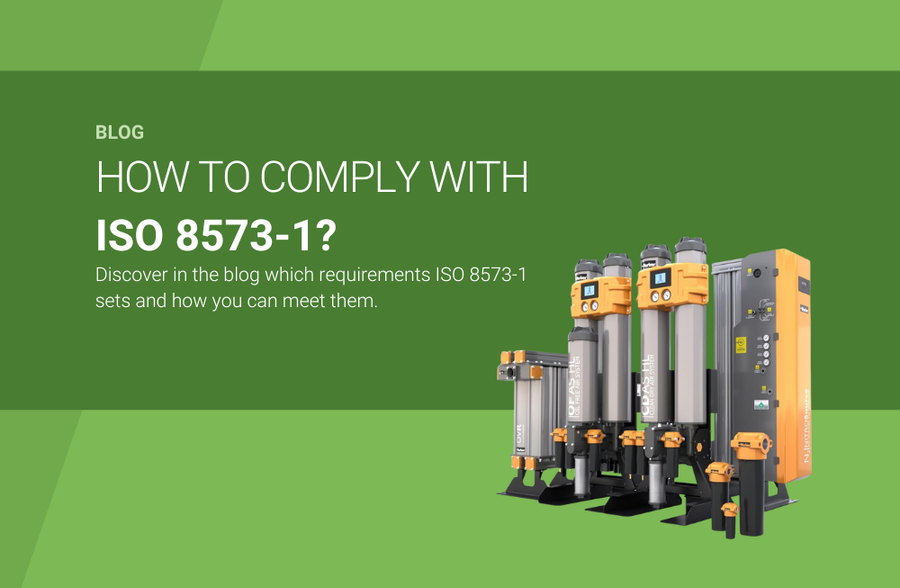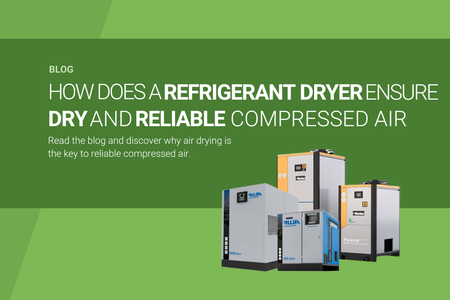
What is ISO 8573-1?
ISO 8573-1 is the international standard for compressed air quality. In many industries, from food production to laboratories, it is important that compressed air is clean, dry and oil-free.
The ISO 8573-1 standard makes it possible to measure and compare compressed air quality objectively. This allows users and suppliers to determine whether their system meets the required specifications.
The three types of contaminants defined by ISO 8573-1
ISO 8573-1 distinguishes three types of contamination in compressed air:
- Solid particles (dust and particulates)
- Moisture (water vapour or condensate)
- Oil (vapour, aerosol or liquid)
Each contaminant is measured and classified separately. The lower the class number, the cleaner the compressed air.
ISO 8573-1 quality classes: what do they mean?
Each class within ISO 8573-1 specifies how clean the compressed air must be. This is defined separately for particles, moisture and oil. The table below shows the maximum allowable amounts of particles, moisture and oil per quality class according to ISO 8573-1.
Each category has its own quality classes, with class 0 indicating the highest purity and higher classes indicating lower purity. The lower the class, the cleaner the air. The higher the class, the more contamination is allowed. For example, to meet class 1 for particles, a maximum of 20.000 particles between 0.1 and 0.5 µm per m³ of compressed air is permitted.

The required quality class varies per application:
- Food and pharmaceutical industry: typically low class values (1 or 2) are required for all three contaminants to prevent contamination or product deviations.
- General industrial applications: high quality may also be needed here, depending on the process. A compressor system used to fill car tyres has lower oil requirements than a process where air comes into direct contact with a product.
- Critical processes such as laboratories or high-purity nitrogen generation often require the lowest class values, as even minimal contamination can affect the process.
In short: the correct ISO class depends on the process and on which contaminant (particles, moisture or oil) presents the greatest risk.
How to comply with the ISO 8573-1 standard for compressed air quality
To meet the required ISO class, compressed air is filtered, dried and purified. Each process demands its own compressed air quality, and the correct combination of filters and dryers is selected accordingly. Below we explain the different techniques.
Removing particles: filters
Filters remove solid particles such as dust, rust and metal particles. This is done using a prefilter and/or a fine filter.
Prefilter (1 µm): captures larger particles.
Fine filter or submicro filter (0.01 µm): removes micro-particles below 1 µm.
Removing moisture: dryers
Moisture in compressed air can cause corrosion, block pipelines and lead to process issues. For example, in nitrogen generation, moisture can disturb membrane operation or adsorption.
There are several types of dryers, each with its own operating principles and application areas. Below are the most commonly used types.
Refrigeration dryer: reduces the pressure dew point to approx. +3 °C (class 4).
Desiccant dryer: reduces the pressure dew point to -20 °C (class 3), -40 °C (class 2) or even -70 °C (class 1).
Membrane dryer: compact solution capable of drying between +15 °C and -40 °C, suitable for smaller installations or point-of-use applications.
Removing oil: activated carbon adsorbers
Oil in the form of aerosols or droplets can be removed by coalescing filters. Activated carbon removes oil vapours from compressed air. The oil is adsorbed, making the air odourless and oil-free. This is essential for processes requiring class 1 or 2.
Activated carbon filters can also be used as point-of-use solutions, directly at the application. These are often used to remove oil locally, for example just before a critical process point.
The complete ISO 8573 series
ISO 8573-1 forms the basis, but the full ISO 8573 series consists of nine parts. While part 1 defines the quality classes, the remaining parts describe how these measurements must be carried out.
.png)
Oil contamination
- ISO 8573-2: measures oil droplets and aerosols.
- ISO 8573-5: combines both measurements to determine the total oil content.
Water (moisture)
- ISO 8573-3: measures humidity in the air.
- ISO 8573-9: determines the amount of liquid water (condensate).
- ISO 8573-1 refers to the pressure dew point for water vapour.
Particles (dust and solid contamination)
- ISO 8573-4: measures the number and size of solid particles.
- ISO 8573-8: determines the mass concentration of solids (in mg/m³).
- ISO 8573-7: describes the detection of microbiological contamination.
- ISO 8573-6: focuses on gaseous contaminants such as CO, CO₂ and NOₓ.
Together, these standards form a complete framework for measuring, monitoring and certifying compressed air quality. This means you not only know the requirements (part 1), but also how to verify them (parts 2 to 9).
The ISO 8573 series is the standard
The ISO 8573 series is the standard for clean compressed air. By applying the right combination of filters, dryers and adsorbers, any required quality class can be achieved, from general applications to demanding industrial processes.
Avilo supports you in designing a reliable and efficient compressed air system tailored to the correct ISO class.
Do you have questions about compressed air quality or would you like to know which solution fits your process best? Contact our specialists, they are ready to assist you.
 EN
EN
 NL
NL

